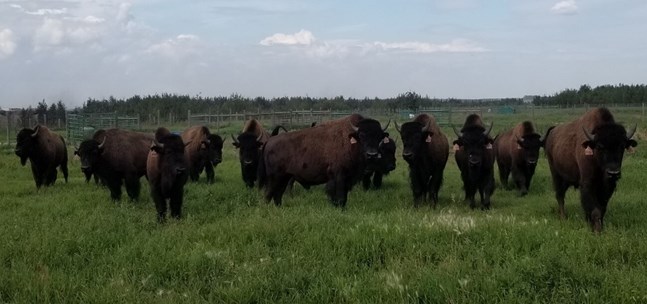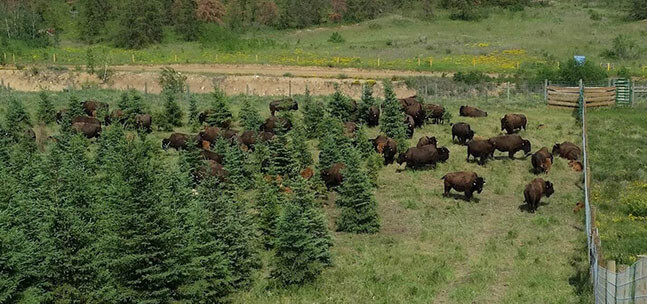Environment
The protection of the environment is an integral element in the conduct of our company business. All our companies will ensure that adverse environmental effects are minimized through careful planning, implementation of effective protection measures and monitoring company activities.
The Fort McKay Group of Companies LP rules and procedures for environmental protection will comply with government regulations and standards and be consistent with industry codes and guidelines. We are also committed to ensuring:
- All of our companies will minimize consequences of emergency events by ensuring prompt effective response.
- Training will be provided to ensure that employees understand their responsibility to protect the environment.
- Employees and contractors must follow the company’s environmental rules and procedures and must always carry out work in an environmentally responsible manner.

Figure 1 Yearling Bulls grazing on reclaimed pasture.
Beaver Creek Wood Bison Ranch
The Beaver Creek Wood Bison Ranch started operations on February 16, 1993, when a herd of 30 pure wood bison arrived at Syncrude’s Mildred Lake site from Elk Island National Park near Edmonton.
Those six mature cows, 15 male calves and nine female calves have grown into a herd of 300 wood bison, living on more than 300 hectares of reclaimed grassland on Syncrude’s former base mine about 50 kilometers north of Fort McMurray.
Brad Ramstead, the ranch manager and a senior reclamation scientist, has run the ranch, a joint venture between Syncrude Canada Ltd. and the Fort McKay First Nation, on behalf of Fort McKay Environment/Fort McKay Strategic Services LP for more than 25 years. Brad began working in reclamation at Syncrude in 1991 and understands the strict controls associated with working on an oil sands site. The ranch takes pride in the safety record of its small, close-knit team that cares for the animals by managing safety for its day-to-day operations and bison handling. The ranch team has gone 6,360 days over 17 years without a recordable injury as of September 30, 2021. The Beaver Creek Bison Ranch is highly respected in the region by Syncrude, the Fort McKay First Nation, clients, management and the Regional Municipality of Wood Buffalo.
The ranch provided employment opportunities for nearby residents, including the construction and maintenance of fences surrounding the spacious bison pasture. The team rounds up all bison every year to tag new calves, weigh, and inoculate the animals. The herd has maintained its disease-free status from tuberculosis and brucellosis since its inception in 1993 and is in excellent health. The herd has been used for research opportunities to support a growing industry. Research has included the cryopreservation of genetic material and seasonal changes of bull fertility. The Beaver Creek team works with researchers to find valuable and pertinent information that benefit the bison industry. The herd is an important part of the genetic preservation effort of the wood bison species.
The ranch will continue to provide a safe and healthy environment for years to come, nurturing the growth and development of this once threatened species.
Cultural importance
The bison is a symbol of strength and has significant cultural importance to First Nation and Métis communities, for whom the animal provided food, shelter and tools for thousands of years. When settlers from Europe came in search of land, bison populations were depleted in massive numbers. Nursing the bison population back to health symbolizes an important part of rekindling Indigenous culture in Canada. The relationship between Syncrude and the Fort McKay First Nation was strengthened when the bison returned to their ancestral land. The ranch also demonstrated the reclaimed land could support the same plants and animals that existed long before anyone began extracting Alberta's oil.

Figure 2 ETB herd enjoying their new pasture area.
East Toe Berm
The ranch began looking for a new pasture location in the fall of 2014. The Fort McKay Group employed a specialist to build a fence in the new location, a pasture east of the Mildred Lake Settling Basin referred to as the East Toe Berm (ETB) that was more of a traditional boreal setting with a mixture of trees and grassland. The north herd was moved and placed in winter holding pens located at the ETB in February 2018.
The project was completed the following summer. This included the complete relocation of the entire north handling system and the creation of adjoining holding pens and alleyways at ETB. The 2018 grazing year would prove to be a challenge to locate the herd at times in their new environment. Bison behaviors did not take long to change, evident by cows seeking escape cover in trees with newborn calves, making it a chore to quantify new calves. Locating the herd at times was a challenge as driving to all locations was not possible with the mixed forest and slopes in all ETB pasture locations.
Beaver Creek Wood Bison Ranch Interesting Facts:
- In 1993, talk of reclaiming some of the land used by Syncrude’s past mining operations evolved into the idea of introducing large mammals to test the land’s sustainability.
- Both cattle and elk were considered before it was suggested that Syncrude reintroduce an animal that had once roamed Alberta’s boreal forest - the wood bison.
- The surplus stock of wood bison on the ranch are sold off at auctions annually.
- The Calgary Zoo stores the genetic material of the Beaver Creek herd for research since Syncrude keeps detailed records of pedigree.
